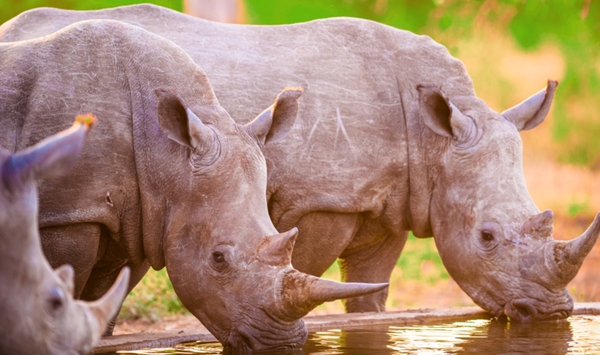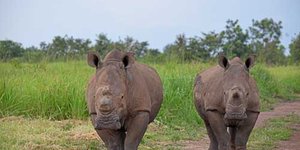Like this article?
Go on, give it a kudu!

Published on August 23 2013
Written by:
Alex Raza
1174 views
Wildlife conservationists around the world are in a state of uproar over the recent proposal for the legalization of the sale of rhino horns announced by Edna Molewa, South Africa's Minister of Water and Environmental Affairs. The minister said she will formerly make the proposal “to introduce regulated international trade in rhino horn” at the 2016 meeting of the Convention on International Trade in Endangered Species of Fauna and Flora (CITES) which will take place in South Africa in that year.
The government wants to cripple the black market by launching a once-off sale of part of its billion dollar stockpile of rhino horns. The move is part of its intervention plans to address the rising poaching problem and the country's Cabinet has approved the preparation and submission of a proposal for the consideration of the 17th CITES Conference in 2016. The Cabinet has also approved the formation of a special task team to assist in the preparation of the proposal and take in numerous aspects, including the anticipated changes in the market, the possible rise in demand for the horns, the appropriate model for the trade, and new control measures to handle the distribution to potential buyers.
The international trade in rhino horns was officially banned in 1977 by CITES after their demand almost caused the extinction of the animals all over the world. The ban was successful in some ways and it has greatly helped to curb the killing of the animals but the rising number of rhino deaths, particularly over the last five years, requires conservationists to come up with more creative methods of protecting the animals. According to the South African Department of Environmental Affairs, 514 rhinos have been killed as of the end of July and this year's total is likely to surpass last year's 668, which itself was almost eight times the total of 2008.
The government of South Africa has almost 36,237 pounds of stockpiled rhino horns and there are 2,091 kilograms more in private hands. South Africa is also the primary custodian of Africa's rhinos, with 93 percent and 40 percent of the total white and black rhino populations respectively. Many of them – particularly those in Kruger National Park - are being poached to extinction and their horns are sold to Asian countries whose people have been fed the medically disproven myth that rhino horns are a cure for all kinds of conditions ranging from cancer to hangovers. These unsubstantiated beliefs have fueled the demand for the horns which can sell for up to $500,000 apiece on the black market.
In theory, legalizing and regulating the sale of rhino horns could help to meet the Asian demand and generate the necessary funds needed for conservation. The legal horns will also be cheaper and easier to obtain than the ill-gotten ones, and thereby lower the incentive for poachers to slaughter the animals for a huge payday. If passed, the new policy would promote safer rhino horn farming. Rhinos can be sedated and parts of their horns can be cut off safely. The horns can grow back after a while and there won't be any need to kill the animal.
Despite the potential benefits, legalization remains highly controversial among animal right activists and wildlife conservationists. Prominent groups like the World Wildlife Fund, the International Fund for Animal Welfare, and the Environmental Investigation Agency are all against the idea.
Legalization could increase the demand in Asian countries and give vendors freedom to wrongly advertise and validate the false medicinal properties of the horn. Critics of the proposal believe that the South African government's efforts would be better directed toward fighting the very misconception that drives the demand in the first place.
South African officials who support the legalization stress the need to choose the most effective plan of action simply because time is running out. Edna Molewa told CNN last month that the extinction of the rhino population is imminent. In fact, one of the subspecies, the western black rhino, was officially declared extinct just two years ago. The minister further stated that it would be a long and hard process to convince the people who believe in the medicinal properties of the rhino horn otherwise, and by the time awareness and education efforts bear fruit, the rhino population in South Africa will have been decimated.
“We think that this is probably one of the measures that can actually help us alleviate this problem,” Molewa told CNN.
If her proposal is approved by the members of CITES in 2016, it could flood the market with stockpiled horns and regulate the trade, send their prices tumbling down, and thus remove the incentives for poaching. If legalization works, it can ultimately help to prevent further mass killings of the species and save them from imminent extinction.
Has been on: 0 safaris
Dissident.
© Your African Safari Ltd, All rights reserved.
Your African Safari is a safari-planning and safari review site. It was created to help support a healthy African wildlife population. All reviews are vetted before being approved and only ethical tours are published

Garamba National Park—an anchor of hope in the Democratic Republic of Congo
Published on January 09 2025
By: R.W.

Namibia imposes new visa requirements
Published on July 25 2024
By: yourafricansafari.com

Do I really need travel insurance or travel protection for my safari?
Published on July 30 2024
By: yourafricansafari.com